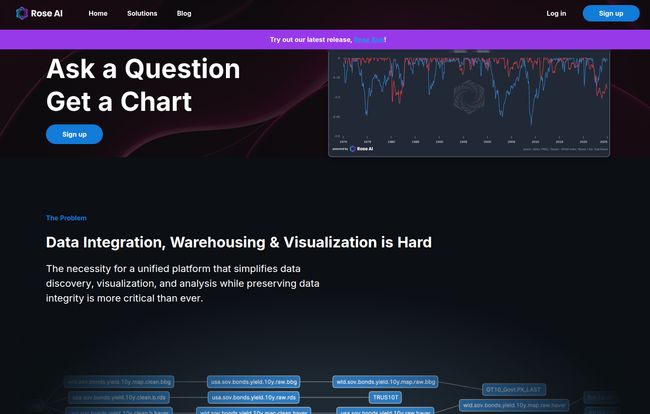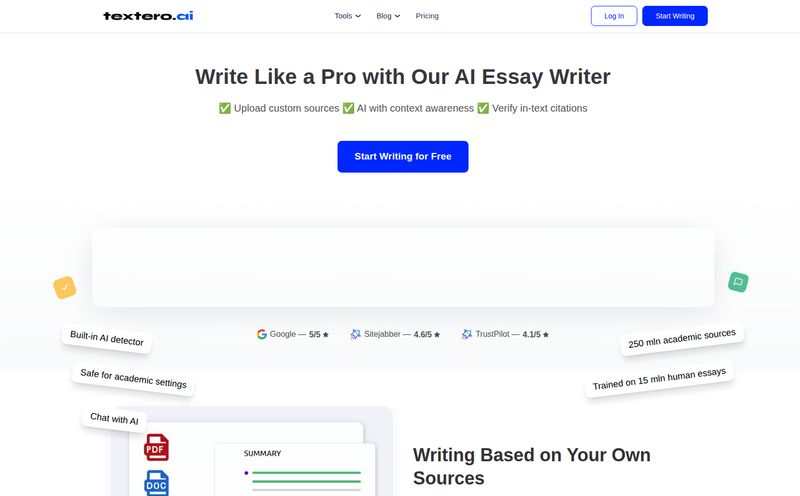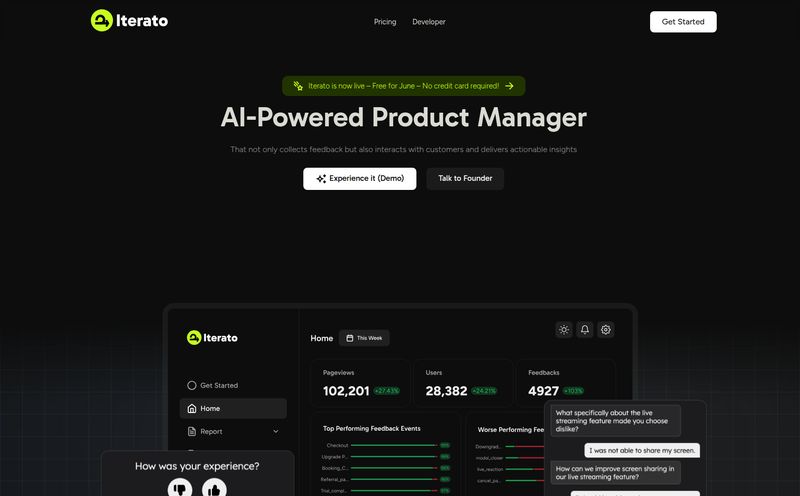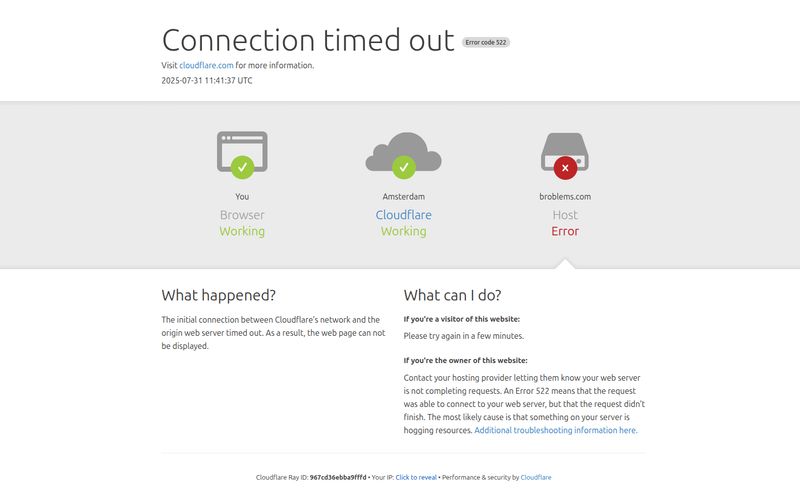If you've ever worked in a role that relies on data—which, let's face it, is pretty much every role these days—you know the pain. The real pain. It's not the analysis itself. It's the grunt work that comes before. The endless cycle of downloading CSVs, wrestling with ten different spreadsheets, trying to merge data sources that just don't want to play nice, and praying your VLOOKUP doesn't crash Excel for the fifth time. It's a special kind of digital purgatory.
We've been promised solutions for years. Shiny BI tools that require a month of training, and data warehouses that become data graveyards—places where good data goes to die. So, whenever a new platform pops up promising to fix all this, my professional skepticism kicks in hard. But every so often, something comes along that makes you lean in a little closer. That's how I felt when I started looking into Rose AI.

Visit Rose AI
So, What Exactly is Rose AI?
On the surface, Rose AI bills itself as a cloud data platform designed to help you find, visualize, and share data. Okay, nothing earth-shattering there. But the devil, or in this case the genius, is in the details. It's built from the ground up for a specific crowd: financial analysts and high-level decision-makers. People who don't have time for nonsense and for whom data integrity isn't just a nice-to-have; it's the whole game.
The entire philosophy seems to be about closing the gap between a question and its answer. Instead of a multi-step, multi-tool process, Rose AI wants to create a single, fluid environment where you can pull in your internal numbers, grab external market data, ask a question in plain English, and get a clean, verifiable chart. It’s an ambitious goal, but one that desperately needs solving.
The Core Features That Actually Make a Difference
A feature list is just a list until you see how it solves a problem. I’ve seen a million platforms with a “data visualization” bullet point. What I care about is how it works and if it actually makes my life easier. Here’s what stood out to me about Rose AI.
You Can Literally Talk to Your Data
This is probably the biggest hook. Rose AI integrates Natural Language Processing (NLP) and Large Language Models (LLMs) right into its core. What does that mean in practice? It means you can type things like, “Chart the equity returns for our top 5 holdings against the S&P 500 over the last two years.”
Now, I know what you’re thinking. “Can’t I just do that with ChatGPT?” Not quite. The difference is where the data comes from and how it's handled. Rose AI isn’t just pulling from a vast, generic web scrape. It's querying connected, curated data sources—your own internal databases (like Snowflake or PostgreSQL), Excel sheets, and data from its own marketplace. This makes the output far more reliable and contextually aware. It’s less of a creative writing partner and more of a highly-caffeinated, brilliant research assistant.
Visualizations That Don't Require a PhD
The platform is designed to get you from a query to a chart. Instantly. The visualizations I've seen are clean, dynamic, and professional. This isn't about creating some wildly artistic infographic for a marketing deck; it's about generating clear, decision-ready visuals for people who understand the numbers. The focus is on speed and clarity, which I can appreciate. Too many tools give you a thousand customization options that just end up creating visual noise.
The 'Show Your Work' Feature: Why Traceability is King
This might be the most important feature, and it’s something I preach about constantly in the SEO world. Citing your sources! Rose AI has something they call “Logic Trees.” Every single data point on a chart is traceable back to its source. You can click on a point and see exactly where the number came from, how it was calculated, and what other data it was combined with. Think of it as the “show your work” section from your high school math test, but for multi-million dollar decisions.
In finance, this is non-negotiable. But even for me, in marketing and traffic analysis, this is huge. How many times have you seen a chart in a meeting and someone asks, “Where did that number come from?” and the presenter just sort of… shuffles their feet? Rose AI aims to kill that moment forever. And for that, it deserves a medal.
Who is This Really For?
The marketing is laser-focused on financial analysts, and it's easy to see why. The language, the use-cases, the emphasis on traceable market data—it all screams Wall Street. But I think that might be underselling it a bit.
Honestly, any data-heavy department could find this useful. A Chief Marketing Officer trying to correlate ad spend from multiple platforms with internal sales data. An operations lead tracking supply chain costs against commodity market fluctuations. The core problem—disparate data sources and the need for quick, reliable answers—is universal. So while finance is the obvious entry point, I wouldn’t be surprised to see its use spread.
The Good, The Not-So-Good, and The Pricing Mystery
Alright, let's get down to brass tacks. No tool is perfect. The upside here is pretty clear: it’s an intuitive, powerful platform that solves a very real, very expensive problem. The NLP integration feels like the future, the traceability is a godsend, and the ability to connect to basically any data source you can think of is a massive plus. The collaborative features also mean you're not just creating charts in a vacuum; you can share and build upon insights with your team.
But there are some things to consider. Any platform this powerful will have a learning curve. It might be intuitive, but to really get the most out of it, you'll need to put in some time. And since it relies on LLMs, there’s always the potential for… quirks. An occasional misinterpretation of a query is probably unavoidable, though I imagine it's something that improves over time. And the integrations are pretty solid to, but you'll still need some technical know-how to get all your pipes connected properly.
And then there's the price. The website, in classic enterprise software fashion, doesn't list a price. You have to “Contact Us.” This usually means two things: it’s not cheap, and the pricing is likely bespoke, based on your team's size and needs. This isn’t a tool you’ll expense on the company card for $20 a month. This is a considered, top-down purchase. Which, given the target audience, makes perfect sense.
Let's Talk About the Data Marketplace
This was an interesting twist I didn't expect. Rose AI includes a data marketplace where users can preview, buy, and even sell datasets. This is fascinating. Imagine you're a research firm that has created a highly valuable dataset on consumer trends in a niche industry. You could potentially monetize that data by listing it on the Rose AI marketplace for other analysts to use.
It creates a potential ecosystem within the platform itself. It turns Rose AI from just a tool into a data hub. The success of this will depend entirely on adoption and the quality of the data listed, but it's a bold and forward-thinking idea that I'll be keeping an eye on.
My Final Take: Is Rose AI Worth a Look?
I’ve seen a lot of tools come and go. Most are just slight variations on something that already exists. Rose AI feels different. It’s not just another BI dashboard. It's a thoughtful attempt to redesign the entire workflow of a data professional, from discovery to presentation.
Is it for everyone? No. If you’re a small blogger just tracking your own traffic, Google Analytics is fine. But if you’re part of a team that lives and breathes data, if your company's success depends on making fast, accurate decisions based on complex data sets, then yes. Rose AI is absolutely worth a look. It’s a serious tool for serious professionals.
The combination of natural language queries, ironclad data traceability, and a collaborative environment is a potent one. It feels less like software and more like a new member of your analytics team. A very, very smart one.
Frequently Asked Questions About Rose AI
1. What kind of data sources can Rose AI connect to?
Rose AI is designed to be highly flexible. It can connect to a wide range of sources, including major data warehouses like Snowflake and Databricks, databases like PostgreSQL, and even standard file formats like Excel. The goal is to integrate both your internal proprietary data and external sources.
2. Is Rose AI difficult to learn?
While the platform is designed to be intuitive, especially with its natural language search, there will be a learning curve to master all its features. Its power lies in its depth, so expect to invest some time to become a power user, particularly when setting up complex data integrations and custom datasets.
3. How does the NLP/LLM feature work?
It uses advanced language models to interpret your typed questions. You ask for a specific piece of analysis or a chart in plain English, and the AI translates that into a query that pulls from your connected data sources to generate the answer or visualization. It's designed to make data discovery more conversational.
4. What is the Rose AI Data Marketplace?
It's a feature within the platform that allows users and third-party providers to buy and sell datasets. This enables companies to monetize their unique data or acquire specific external data they need for their analysis, all within the Rose AI ecosystem.
5. How much does Rose AI cost?
Pricing information is not publicly listed on their website. This typically means they offer enterprise-level, customized pricing plans based on factors like the number of users, data volume, and specific features required. You'll need to contact their sales team for a quote.



